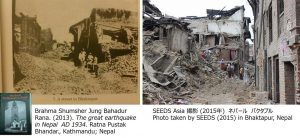The Collective Memories of Disasters in Asia: Nepal-Gorkha Earthquake
BUILD BACK BETTER- Challenges in making use of disaster experiences and lessons
Five years have passed since the Nepal-Gorkha Earthquake of 2015. The earthquake resulted in the loss of 8,964 lives and destroyed scores of homes and other buildings.
During the days after the disaster, SEEDS Asia, together with SEEDS India, decided to dispatch staff members for emergency support to Nepal. Based on the initial survey of the affected areas, 335 households of Jhangajholi Village Development Committee in Sindhuli District were chosen as the recipients of daily necessity goods. The gratitude of the residents when they received tents and other support kits prepared by us (based on the SPHERE Standards) are unforgettable.
Later on, up until 2018, SEEDS Asia continued to extend assistance towards resumption of schools in the village by distribution of learning kits to affected students, installation of school furniture, psychosocial care and disaster risk reduction education for the students and the community to understand and embrace the risk of floods and aftershocks. The support that we received from all over the world went a long way to support our local activities in Jhangajholi.
Upon visiting the affected areas and witnessing the devastation after the earthquake, we were reminded of the challenge of “Build Back Better” – the concept of rehabilitation and reconstruction efforts that created a community better and more resilient than it was before the disaster. The place had, in fact, experienced a Magnitude 8.1 earthquake called the “Bihar–Nepal Earthquake” about 80 years ago, and the scenery we were witnessing was similar to what we saw in photos of the impact of the earthquake decades ago. We wondered what were the lessons learnt from that earlier disaster.
Disaster-affected communities always wish that they can return to normalcy as early as possible, which often imposes time constraints. We also need to pay attention to the balance and mix of traditional lifestyles and new technologies when implementing “Build-Back-Better” policies. The lesson that we clearly learnt was that, when we aim at making communities more disaster-resilient than they were before a disaster, we must face the complexity of ensuring that disaster recovery is not merely restoration of destroyed structures.
The experience has inspired SEEDS Asia to continue to build resilient communities in Asia for the realization of a society where lives, communities and hope for the future will be protected. We would like to hope that the souls of the victims of the Nepal-Gorkha Earthquake rest in peace, and wish for a peaceful day for everyone who was affected by this disaster.
